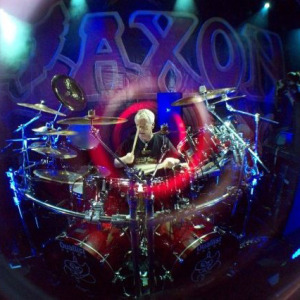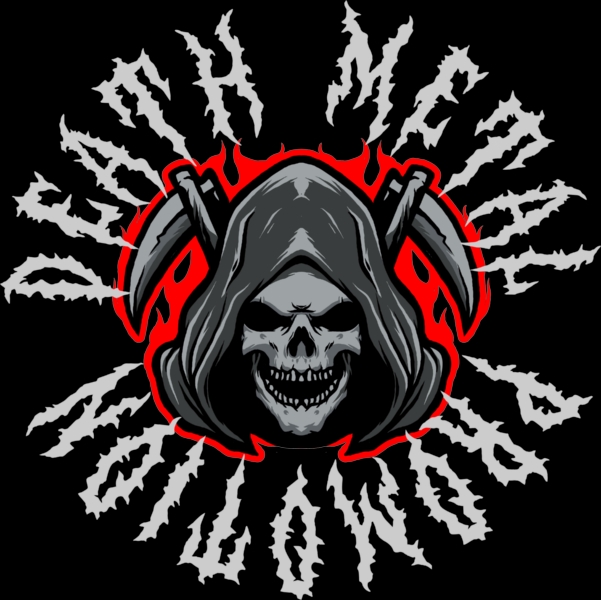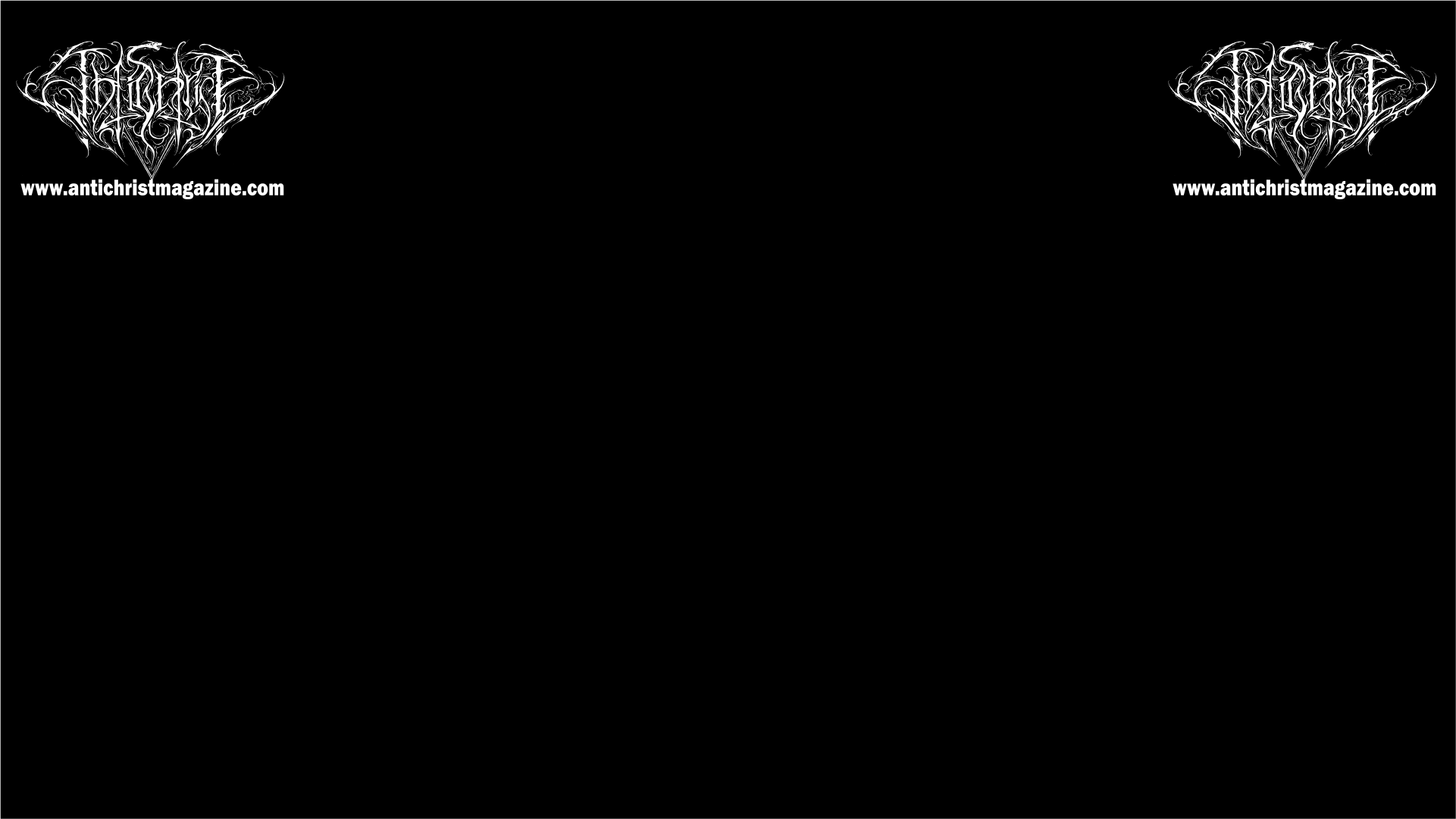 You have been Saxon’s longest running drummer, having rocked with them for nearly thirty years. You’ve had an AMAZING career with Saxon, appearing on twelve studio albums, and six live albums. You’ve played the biggest festivals, with the biggest names in metal, and appeared in numerous music videos. How has it been?
You have been Saxon’s longest running drummer, having rocked with them for nearly thirty years. You’ve had an AMAZING career with Saxon, appearing on twelve studio albums, and six live albums. You’ve played the biggest festivals, with the biggest names in metal, and appeared in numerous music videos. How has it been?
Bloody hard work! – but great fun at the same time – and i’ve visited countries that i might not have gone to otherwise, met loads of people, made a lot of friends, both in and out of the music business.
It’s been a fantastic career – there have been highs and lows, the normal stuff that everyone goes through during their lives, but i’m proud of what I’ve achieved, and proud of what we, as a band, have achieved too. Long may it continue!
You were in Saxon during the height of the 80’s metal scene, right in the heart of the NWOBHM movement. What a ride that must have been! What was it like? Any wild stories that stick out?
Wild stories? – too wild for you!! – ha!
Seriously though, as I said in the answer above, it was a great time – I was buying a lot of heavy rock albums, and a lot of these guys were coming to our shows, so it was really cool to meet them – I remember the Tygers Of Pan Tang came to our Newcastle gig on that first tour I did with Saxon.
Then in Germany, the Scorpions came to a few shows – on the next UK tour Brian Johnson came down to see us in Newcastle – the local curry house got hit both nights – and these were people in bands I loved.
Again, as i said above, it’s been so good to meet all these different musicians down the years, and, in some cases, been able to play with them.
You joined Saxon in 1981 and then left six years later to join GTR, a band founded by former Yes and Asia guitarist Steve Howe, and former Genesis guitarist Steve Hackett. What propelled you to leave a six year running time with Saxon? GTR has a completely different sound as well. Stark contrast to the heavy metal sound of Saxon. No sooner than you joined GTR, everything was abandoned. Why? It was after this you immediately rejoined Saxon.
It was nothing to do with the band as such – I just had a mega problem with our management at the time – I’m not going into this in any detail but I just had to get away from the situation – we were being treated so badly that I couldn’t go on – so when I was contacted by Brian Lane’s office offering me the GTR gig, this was my escape route – and yes, I know it was a different genre of music, but it was actually closer to the kind of stuff I was listening to – and to play with Steve Howe – wow, that was a privilege – Steve Hackett had left by this time, which was a shame, as i’m a huge Genesis fan.
We started recording the second album but there were a lot of politics going on in the background – not with the guys in the band I must say! – Brian Lane had been Yes’ manager, and Asia’s, and I think, with the success of the Trevor Rabin Yes, Brian was maybe looking at an album with the other Yes members – however, I’m not saying that this is what happened. Maybe it was a plan by the record label. Steve was the only one signed to the label and, with about three weeks to go to finishing the tracking, Arista pulled the plug – we were all gutted! I think it would have outsold the first album.Then a few years later, the Anderson, Bruford, Wakeman, Howe album comes out – on Arista!! So who knows what went on. It was such a waste. I’d love to go back in the studio and re-record the whole album, get it finished, mixed, and put it out.
A while after GTR fell apart, I was contacted by Saxon’s management asking If i’d do a tour with them and record a live album, so there I was, back in the fold!!
In 1998, you left Saxon a second time because of torn muscles in your neck and shoulder, and doctors had advised you to stop drumming. Two years later, you made a solo album with Saxon guitarist Doug Scarratt titled Mad Men and English Dogs. Why did you start drumming again against doctors advice and why the solo album instead of the return to Saxon?
I was told to stop playing for around five months to allow the muscles to get better, but I still did some writing with Saxon – I did a small synth intro on Metalhead and then, a couple of years later, I was involved in writing sessions for Killing Ground – I went up to the studio we always used and co-wrote three or four songs on that album, playing drums during the process. There was never a question of me having to stop for good. I was asked if I wanted to rejoin but I didn’t think it was fair to Fritz to take the drum stool away from him as he was doing such a great job. He just wasn’t into composing and that’s why I went up to the writing sessions. Later on, a couple of tracks from Lionheart were started at my house, with Paul and Doug – Witchfinder General was one.
As for Mad Men, see the answer below.
Mad Men and English Dogs is an awesome album! Sensational guitar and drum playing. It needs more attention! Where can people purchase this gem?
Thanks for the compliment! – I started writing it during the period where I had to allow the torn muscles to heal and then asked Doug to join me in the project – he was living in the same town as me – just around the corner actually! – and so we continued with the composing until we had the makings of a complete album – it took a couple of years because of Doug’s Saxon commitments and the fact that I had to make sure I was 100% ok to drum again – quite a few tracks have been used on TV programmes all over the world. If anyone is interested in buying it, please send me a PM on Facebook – Nigel Glockler – and we can get it sorted out!
You eventually did return to Saxon in 2005, two years later making The Inner Sanctum album. Lemmy Kilmister appears on this album. How did you guys approach him about being a part of it. He was in the video too which was awesome. What was it like working with Lemmy? How did his death affect you guys?
We were really good friends with Lemmy – the guys had known Motorhead for a long time – I think they toured together a lot in the early days.
Motorhead and Saxon were on the same label around this time so it made sense to get him on that track – we’ve toured a lot with them down the years, or our paths have crossed at festivals – the final time being last autumn, just before he passed away. We had toured the US with them that summer and one could see he wasn’t in the best of health – he was such a nice, genuine man – on that tour he was more concerned with my health, after the brain operation, which really humbled me, but every day he made a point of asking me how I was feeling – was I ok?
It was a terribly sad day when he died but he was so frail towards the end. I know it hit Phil and Mikkey really hard – Phil and I have been friends since 1977.
In December of 2014 you suffered a ruptured brain aneurysm while on tour with Saxon. Can you tell us about that?
We were coming to the end of a particularly brutal tour – by which I mean, not many days off, long travel distances etc – this was one of the days off and I was in my hotel room in Gateshead, reading the news on my laptop, when my head exploded with pain, like the worst migraine you can imagine, my vision went blurry, as if i was underwater, and my neck seized up – then i started being violently ill – i collapsed onto the bed during which time, Gina, my wife contacted me. To cut a long story short, she heard my speech was slurred, she googled the symptoms and got an ambulance ordered – this was urgent – and basically, she saved my life by her quick thinking. I was rushed into hospital, first in Gateshead, then Newcastle, where I had two brain operations, one through my skull, where they clipped the bleed. I was there for a month, stuck in bed over Xmas and New Year.
It was an awful and scary time. Finally got home at the beginning of January and two days later, having been away for ten weeks, I had to have my cat put to sleep as his kidneys stopped working – so not a happy time at all!
Anyway, March came along, the tracks for Battering Ram were recorded, and in April I played my first live gigs. In summer, I had a CT scan/angiogram for my local neurosurgeon, and I was given the all-clear and discharged although he couldn’t believe i was back touring so quickly – he thought a year to eighteen months before i’d be ready! The first time I saw him in february, before i’d even sat down in his office, he said I was a very lucky guy as one in three people with this never get to the hospital alive.
It’s awesome you’ve been up and working after that happened. You’re back performing live, you guys just released a new album last year called Battering Ram. What are the 2016 and beyond plans for Saxon? Do you guys have plans for another album? Any upcoming tours and festivals?
We’re doing a load of festivals this year, and then a UK/European tour is being finalised for the autumn/winter – the best thing to do is to have a look at the Saxon website – saxon747.com – all the dates will be up there, plus other news. We’re starting the writing process for the follow-up to Battering Ram shortly too.
Album review time! Now this is just my opinion. I’ve heard all of the Saxon albums you’ve been on. Power and The Glory was a great old-school heavy, metal classic album, then later albums were a mixture of rock and metal, a few ballads. But, wow, starting with The Labyrinth, it’s as if Saxon’s sound just got straight up metal all the way around. I’m talking hard, heavy metal. For me, Sacrifice would be first, followed by The Labyrinth, Battering Ram, Call To Arms, in terms of heaviness. What brought about this sudden change in Saxon’s music? Did the arrival of guitarist Doug Scarratt change things a bit?
We never set out to write in a certain direction although outside forces can influence you subconsciously – by that I mean what you’ve been listening to etc. One thing is that we will tend to decide if an album is going to be more heavy, or less heavy, or more straight ahead rock and roll, but we write how we write, end of – again, a lot of that is down to the production. Also, towards the end of the process, certain songs might be left off because they don’t suit the general vibe of the album – maybe we’ll come back to them at a later date.
We tend to compose stuff we like – we won’t let any old thing go on an album – it’s got to be great.
When a new member joins a band, of course things change a little – when Nibbs joined, and later on, Doug, the sound of the band went through a change each time – I think that goes for any member, instrument etc. Also, producers can influence you a lot – every producer does things his way, has his certain sounds etc etc, although, obviously, Saxon plays like Saxon, so that nucleus is always there, the bedrock so to speak. But I must say that I honestly think we’re improving all the time as writers, and also as players, so that must influence things too.
You’ve done some work with Paul Di’Anno and Dennis Stratton, both former members of Iron Maiden. Tell us about that.
That was through Lea Hart, who was the singer in Fastway at that time – He and his friend Chris were writers and producers and, after Nibbs and I had recorded the Fastway album, Bad, Bad Girls, Lea asked us to do other sessions for them on various projects they were involved with – and Paul and Dennis happened to be part of the equation. We did some recording in Lincolnshire and London.
You’ve played with some other bands besides the ones mentioned in this interview. Can you give us a brief overview of the other bands you’ve played in?
My first professional band was Krakatoa – I still do a lot of composing with the guitarist, Roger Adams – an amazing player!! – and one of my best friends. The keyboard player was Hans Zimmer, of movie soundtrack fame!
The main one really was Toyah – i’d been with her band since the end of 1980 – we released an album and three singles during that time – all top five in the UK charts, and toured twice around the UK. The album was Anthem, and the singles were It’s A Mystery, I Wanna Be Free, and Thunder In The Mountains.
I left them in autumn ’81 to join Saxon.
Through the GTR connection I obviously met Steve Howe so I played on some of his solo stuff – a track on Guitar Speak, and a couple of tracks on Turbulenz.
I played some tracks on Asia’s Aqua album, plus a few more on the Archiva vol1 and 2 cds – Geoff Downes was producing GTR so that’s how this connection came about.
Tony Martin’s first solo album. Fastway, Lea Hart solo albums, Iron Men, Paul Di’Anno, A Japanese soundtrack for a cartoon-type movie – Kaizoku – and Lea and Chris were again involved.
Steve Ellis – ex Love Affair,The Associates, Chameleon, 39, Lyon Street – an Associates project – Adrian Lee, Bernie Torme – Turn Out The Lights, Winter’s Reign, Desperate Dan Band, Thunderstorm, The Muffin Men, Max Bacon, Charlie – not the band! , Celtic Spirit – that was more for writing a track.
A question I always want to know is how musicians got their start playing their particular instrument. Tell us the beginnings of your drumming journey.
I started playing at the age of seven when my parents bought me a snare drum and a cymbal – before that it had been the usual – setting up a circle of tins, metal plates, etc on the floor and pummelling them with forks and knives etc – but a friend of the family noticed I was always tapping along with music so he had a little word in my Dad’s ear! A bass drum and hi-hat turned up one Xmas but I then started getting interested in guitar – however, I noticed that I was always listening to the bass parts so a sacrifice had to be made – my Hornby Dublo three-rail train set went and a beautiful Hofner Senator bass joined the household! – So there i was, playing along to Cream and the Moody Blues amongst others.
Then I had a go on another kit at school and decided that the drums were for me! We had a school band playing songs by Jethro Tull, Free, Procul Harum, Hendrix stuff, all sorts – and we gigged locally too! After that i played with various local bands until Krakatoa came along and offered me the gig with them.
However, being a professional musician wasn’t my first choice of career – I really wanted to be a vet but you needed to pass Latin exams and I was useless at it!
In all the time you’ve been drumming, who are the most notable acts you’ve shared the stage with?
There have been so many down the years, nearly always at festivals – two that pop into my head are Saga – Ian Crichton is an astounding guitarist – and Toto – Simon was playing with them at this time – but I don’t want to leave anyone out so i’m not saying anymore!! We’ve shared stages with some wonderful bands.
You play other instruments besides the drums, among them being the bass, piano, keyboard, guitar, mellotron and talking drum. What is a mellotron and talking drum? What made you stick to playing drums?
I just think that I was more into drums than any other instrument at that time – I was more proficient on the kit than I was on anything else – I can play a bit of bass and guitar when it comes to putting ideas down – the same with keyboards – i’m no Rick Wakeman unfortunately!!
Talking drum? – I didn’t know i’d used one? – I just grab things and play around with them – half the time I don’t know exactly what they are but I like experimenting!
A mellotron – now that’s a different thing entirely – my favourite keyboard – the flutes on the Beatles track Strawberry Fields come from a mellotron – it was the first sampler I believe, and all the sounds were on tapes which were operated by pressing the keys – Genesis used it a lot as did Yes, The Moody Blues, and King Crimson, among others.
That’s cool how you participate in writing other musical parts for Saxon such as guitar riffs using a keyboard. How do you do that?
Basically i’ll either use a guitar sample and play a riff on the keyboard – so it sounds like a guitar doing it – or i’ll use other sounds, like strings, to play the riffs or melodies and the guitarists will transpose the ideas to their own instruments.
Are there any other drummers that have influenced you?
Too many to mention – my favourite all rounder is Simon Phillips, but Bill Ward was an early influence – I like different players for certain things – Vinny Colaiuta is an amazing groover but then he’ll throw in a crazy fill which stuns you and then go back to the groove for the rest of the track – he is such a tasteful player.
I also like Lenny White, Billy Cobham, Neil Peart, Phil Rudd – as soon as he starts, your feet start tapping instantly – a great example of groove playing! There’s Dennis Chambers, Dave Weckl, Thomas Lang, Phil Ehart, Phil Collins, etc etc – and i’ve been watching some real jazzers – Buddy Rich, Papa Jo Jones, Joe Morello – I don’t think you ever stop learning!
Do people still call you The Rex? How did you get that nickname?
I studied Geology at school, and I’ve always been interested in dinosaurs, particularly the T-Rex – i love movies with dinosaurs in, particularly the Ray Harryhausen ones – and I was blown away by the T-Rex in Jurassic Park and the sequels – I know the CGI ones are more realistic but, as a kid, the jerkiness of the old films made the creatures more scary and menacing to me – also, the original King Kong is a masterpiece! – so I guess that’s where it came from – plus I’ve got smallish hands, compared to a lot of people, as did the Rex – no-one calls me that now though.
You appear in a book called Mad Bad and Dangerous: A Book of Drummers Tales. Can you tell us a Nigel Glockler drummer tale? One that stands out the most.
I set my roadie on fire once!! – I was using some sticks with rags on the ends which had been soaked in lighter fluid – during my solo, my tec would soak these behind me, the lights would go out, he’d light the rags, and hand me the sticks – this one time the flaming rag came unwrapped and coiled around my hand and arm so, as to avoid getting badly burnt, I threw the sticks away behind me – they landed on the towel which soaked up any excess fuel, promptly set it on fire, and i have this vision of my roadie with a look of horror on his face as the flames shot up his trousers and generally around where he was sitting – I, of course, kept solo-ing whilst various fire extinguishers were brought into action – I’ll never forget his face – he was ok thank god – just a few singed leg hairs!!!
Your current kit is known as “The Monster”. What does it consist of?
Actually this kit i’m using now is either referred to as HMS Glockler or Starship Glockler – i’m a big Star Trek fan.
I have two 22″ kick drums, eight toms – two 8″, 10″,12″,13″,15″,16″ and 18″ – plus various snare drums, and a battery of cymbals.
A new kit is being built for me with two 24″ kicks – other sizes as above – that one will be stored in the US, where I live now.
What advice would you give drummers just starting their craft?
I always tell people to get together with friends who may be starting out too and play – just play – it might sound terrible at first but it will teach you to interact with other musicians – just don’t be a solo bedroom player – obviously one has to learn the basics and here i say, don’t be in a rush to play fast – your body has to get used to playing certain things so start slow and, gradually, as your body gets used to it, the speed will come – i always remember a drum intro on a Spooky Tooth album – first track on the second album – there was a bass drum pattern with off beats that i just couldn’t play, but I slowed it right down, practised and practised until i got it. That’s what you have to do. Then, once you get more confident with your playing, get in a band with people better than you – that will push you to improve your own standard of drumming. Again, one can practise and practise on one’s own, and learn all the rudiments, play everything at 200 miles an hour but what does it mean? – nothing – you have to play for the song and not solo over everything – and play with a click – learn to groove. Just don’t be in a rush – people often ask me how i play the kick drums so fast – actually, compared to some players, I don’t! – but I tell them it’s taken me time to build up to it – it didn’t just happen!!
Do you have any social media sites fans can look you up on? a website?
I have a Facebook page – it’s just a fan page but people can send private messages to me. I have a website -nigelglockler.com – but, and this is terrible, I haven’t updated it in years – and I mean many, many years!! – Mark, my webmaster, puts stuff up from time to time, but he’s incredibly busy with his own life, so I must get onto that as soon as possible – but the Facebook page is fine for info too! I have a Twitter account but I’ve never used it and, quite frankly, I don’t see the point of sharing every second of your life with the world. There’s also the Saxon website.
Time for some fun! Tell me:
1. Things you hate to happen while drumming
Any piece of equipment breaking or falling apart whilst i’m on stage – luckily it doesn’t happen very often nowadays – however, it tests the roadie if I go through a drum head during a show – he has to replace it in situ!
2. What has been the most expensive drum equipment you’ve ever bought?
I bought myself a Tama ‘Imperial Star’ kit back in ’76 when it first came out – cost me a fortune – eight concert toms, two floors, kick, snare etc – I played three shows with it – one with a local Brighton band I was in, then my first two shows with Krakatoa – it was huge – anyway, we were travelling to a gig in the North of England – the four band members and two crew (Hans hadn’t yet joined us) – and we got rammed up the backside by an articulated lorry – at night – our truck ended up on it’s back still facing the same way! – and my kit got totalled! – I watched it disappearing down the motorway under the wheels of passing trucks in hails of sparks! – luckily we all got out – the Police said it would normally look like a butchers shop with no survivors!
Cymbals were expensive too! – when one got broken it was the end of the world!!
The most expensive stuff I buy nowadays is for my studio – keyboards, etc.
3. How do you spend your time away from the drums? Do you have any hobbies?
I love reading about World War 1 Naval warfare – and also the Victorian Navy – ironclads etc, and the first pre-dreadnought battleships – actually all the campaigns the British fought in the 19th century interest me – The Napoleonic Wars, The Afghan War, The Crimea, The Boer War, The Nile War, Zulu Wars, etc etc, but it’s mainly the naval side i’m most interested in – I collect books on that subject – and documentaries – which drive my wife mad!!!
I like to read and also watch tv documentaries on nature – big cats, birds, the countryside in general.
I also grow chillis which I use in my curries – i’m mad on Indian food!
I have a friend who’s a pilot for an Air Museum near Dallas – he takes me up in old warbirds from time to time.
Apart from that I love sitting down in my studio and firing up all the keyboards and synth racks etc – then I turn into Tangerine Dream or Enigma or Vangelis!
4. What are “resonant heads”, “tension rods”, and please explain what the term “kick drum” means.
Resonant heads are the bottom heads on a tom etc or the front heads on a bass drum – in other words, not the ones you hit, but the other ones that resonate with the struck head. There was a time that a lot of players, me included, only used a single head on a tom so there was no resonant head, but I went back to the two-headed toms as I preferred the stick response – more bounce!
Tension rods are just that – you adjust the sound of the drum by tightening or loosening the heads with these.
Kick drum= bass drum – don’t ask me why this term came about – I haven’t a clue either!
Thank you Nigel for this interview. I hope you stay well and keep rocking’!
Thank you Heather – I enjoyed it!
https://www.facebook.com/Nigel-Glockler-211969710145/
If you really would like to support Antichrist, you can just Share our article.
You can also support Antichrist by sending a couple bucks to cover some webhosting expenses. =>> PayPal





